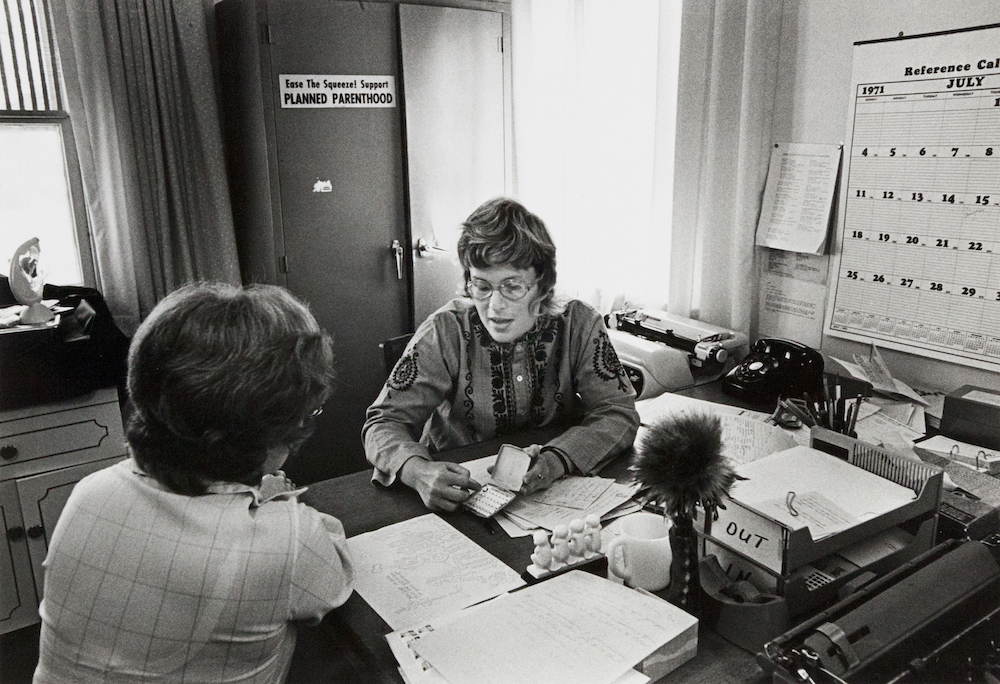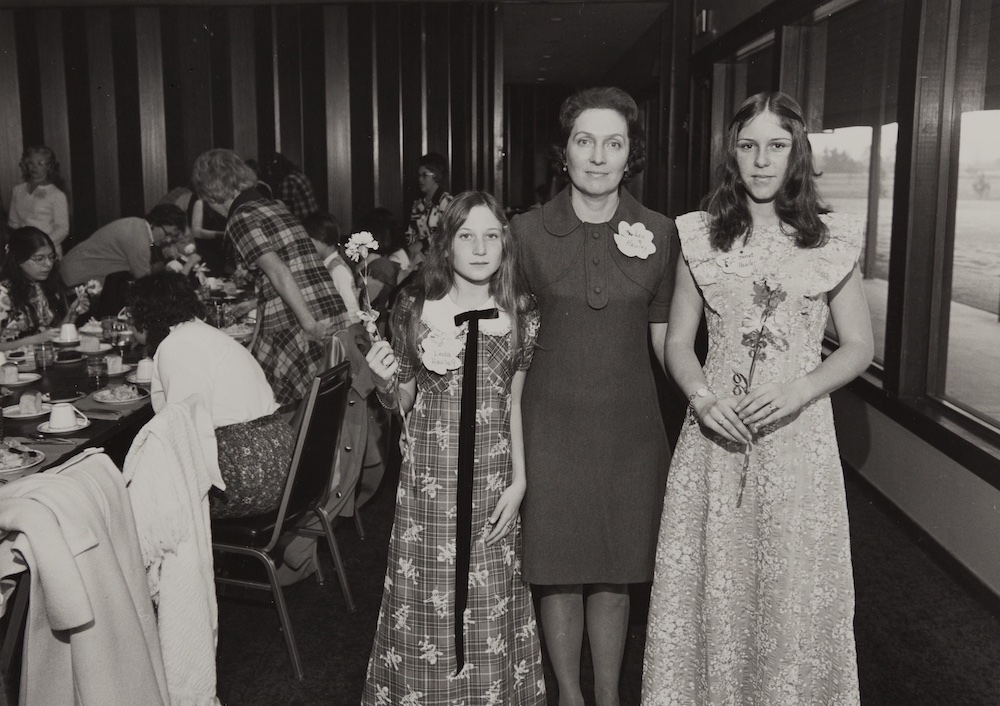III. Women's Labor Outside of the Home: Bill Owens
- Mollie Schottstaedt
Bill Owens is a photographer best known for his depictions of suburban life in Northern California during the 1970s from his series Suburbia. He focused on capturing a holistic story of people’s day-to-day lives rather than staging compositionally focused photographs which would be inaccurate representations. Because he worked for fourteen years as a journalist for the Livermore Independent, he became interested in capturing the everyday in the city of Livermore as well as the ways in which families were embarking on a modern life filled with new technology and clothes.1 The Mills College Art Museum (MCAM) acquired thirty-three of his black and white photos as a gift of Marion Brenner and Robert Harshorn Shimshak in 2012, which specifically depicted middle-class women and girls living in this suburban area. These images of women from Owens’ series Suburbia were chosen specifically because they are representative of MCAM’s mission to acquire artworks which highlight people and cultures which are often underrepresented in the art world.
Within the context of the exhibition Unseen: The Hidden Labor of Women—which shines a spotlight on women’s labor using works from the Mills collection—each of the eight Owens photographs selected for the exhibition show an unseen aspect of women’s labor. The six images used in this essay tell the story of how women’s labor was changing in the 1970s from domestic forms of labor, such as cooking and cleaning, to work outside of the home, where women supported each other, pursued an education, and became part of the typically male-dominated workforce.
Women Making Meatballs is an image of seven women gathered around a table in a kitchen making meatballs (fig 8). Some reach their hands into the raw meatball mixture while others form the balls of meat and a young girl observes in the bottom left-hand corner. The focal point of this photograph is a woman holding her hands in the meat bowl and laughing out of pure delight from the squishy cold texture of the meat and being together with her friends. The little girl in the corner observes a moment of community between several generations of women, participating in the labor of love and food. By witnessing this group of women enjoying a form of labor together, she is learning the importance of support from a community. This photograph is a wholesome, heart-warming, and cheerful depiction of the hidden labor of women in the kitchen. Rather than seeing the final result of their labor at mealtime with a family, the viewer sees the joyful community behind the making of these meatballs in order to appreciate the labor behind the final product much more.
On the other hand, in Owens’ photo Women’s Group with Gown and Cookies, we see the finished product which came from the labor of love in the form of cookies and treats (fig 9). With the snacks in the foreground and the presumed makers sitting in the background with their backs turned, looking at a stage, Owens creates a scene representing the duality of women’s labor. Despite making the cookies beforehand for the gathering, the women turn their backs on typical forms of domestic labor in order to focus on their own passions and community. It is important to understand that although much of a woman’s labor in suburbia might encompasses domestic activities such as cooking, cleaning, and sewing, these women are also stepping beyond the mundane into a progressive and entrepreneurial workforce. Although these women, who have most likely retired, are still participating in domestic labor, they are also stepping outside of their homes to join a group of women interested in being part of a community with similar interests.
In keeping with this progressive and enlightening theme is Owens’ photograph Planned Parenthood of a woman in a Planned Parenthood office receiving counseling from another woman who appears to work in the office (fig 10). The labor of women in the workforce becomes especially relevant when looking at this photograph of an organization dedicated to educating and supporting parents and families in family matters, women’s health, sex education, and pregnancy prevention methods. It is important that women are present in the workforce who are devoted to supporting the creation and preservation of life as well as a woman’s choice, and this photo shines a light on the difficult choices women are often forced to face.
A mother’s labor of love is shown in Owens' photograph Mother/Daughter Banquet, which is a portrait of a mother with her two teenage daughters posing for a photo while at a banquet (fig 11). Unseen includes several mother/daughter images which depict the labor of motherhood by showing the loving embrace of a mother holding their child to demonstrate their support and bond with their children. One of these mother/child images is an etching by Mary Cassatt titled By the Pond that depicts a woman holding her little boy up with gentle hands and looking at him with loving eyes (fig 12). Owens’ photograph is different from these images because it illustrates a mother’s support of her children during pre-teen and teenage years as her daughters become women. The mother/daughter relationship is unique because of the shared experience of becoming a woman, and mothers typically want the best opportunities for their daughters to express themselves in any way they desire.
When it comes to celebrating a girl’s day-to-day life in a primarily white, middle-class suburban environment, Owens’ photograph Girls Collecting Specimens in Water provides another aspect of women’s labor in the form of education (fig 13). In this photograph we see four girls standing in a creek with containers and nets while their teacher instructs them on the specimens in the water. This image is different from many of Owens’ other photographs because it depicts girls being taught science as opposed to participating in domestic and creative education such as participating in marching band, cheerleading, and home economics. It shows how women in the school system are teaching young girls about the world around them and getting them excited and inspired to learn more about things outside of the home. They understand the importance of women working in STEM disciplines and foster a space in which girls can explore and develop their diverse fields of interests in order to pursue them in the future.
Finally, we move on to examine the ultimate goal in the fight to educate women as seen in Owens’ photograph, Two Women, One at Lectern (fig 14). What many mothers and other women desire is for women to claim their spot in all aspects and levels of life, especially ones which are typically masculine, such as the courtroom or debate room. Having women represented in law-making and public policy is important because women make up half the population of the world and need to be involved in the decision making which affects them. If men are the only ones to make these decisions, it is inevitable that they will not be able to encompass the entirety of the woman’s experience in their law-making. Decisions made without involving the voice of women involved are dangerous and can affect generations of women in education, political rights, and their communities.
Although Bill Owens is a man, he chooses to depict women in a realistic and progressive way in his photos. His photographs show women not as objects to be looked at by men, but as laborers who work and strive to make the world a more inclusive place. By depicting women in a way which seriously confronts the typical suburban middle-class role of women in the 1970s, Owens succeeds in painting women’s labor in a new light.
-
Tony D’Souza, “Interview with Bill Owen,” Photo.com, accessed January 01, 2020, https://www.all-about-photo.com/photo-articles/photo-article/615/interview-with-bill-owen. ↩︎






